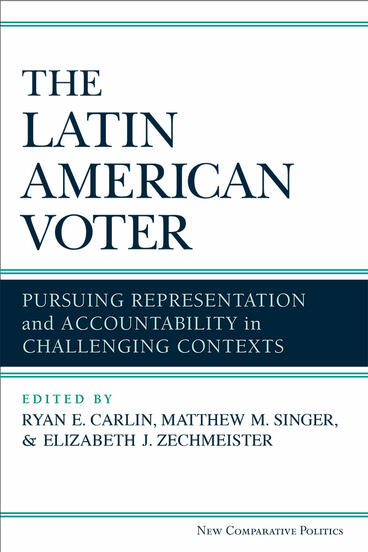The Latin American Voter
Pursuing Representation and Accountability in Challenging Contexts
Public opinion and political behavior experts explore voter choice in Latin America with this follow-up to the 1960 landmark The American Voter
Description
In this volume, experts on Latin American public opinion and political behavior employ region-wide public opinion studies, elite surveys, experiments, and advanced statistical methods to reach several key conclusions about voting behavior in the region’s emerging democracies. In Latin America, to varying degrees the average voter grounds his or her decision in factors identified in classic models of voter choice. Individuals are motivated to go to the polls and select elected officials on the basis of class, religion, gender, ethnicity and other demographic factors; substantive political connections including partisanship, left-right stances, and policy preferences; and politician performance in areas like the economy, corruption, and crime.
Yet evidence from Latin America shows that the determinants of voter choice cannot be properly understood without reference to context—the substance (specific cleavages, campaigns, performance) and the structure (fragmentation and polarization) that characterize the political environment. Voting behavior reflects the relative youth and fluidity of the region’s party systems, as parties emerge and splinter to a far greater degree than in long-standing party systems. Consequently, explanations of voter choice centered around country differences stand on equal footing to explanations focused on individual-level factors.
Ryan E. Carlin is Associate Professor of Political Science at Georgia State University.
Matthew M. Singer is Associate Professor of Political Science at the University of Connecticut.
Elizabeth J. Zechmeister is Professor of Political Science and Director of the Latin American Public Opinion Project at Vanderbilt University.
Reviews
“The Latin American Voter makes a unique, first contribution to a neglected area of electoral behavior. Can the Latin American voter be explained? The authors answer ‘Yes,’ with the proviso that Latin American voters are different. Voting in this region, they conclude, depends on context, heterogeneity, institutions, country, and ballot choices. In sum, they discover the Latin America voter as not one, but many. This perhaps surprising finding deserves a careful read by anyone wanting to understand elections in this part of the world.”
—Michael S. Lewis-Beck, University of Iowa
“. . . makes a significant contribution to Latin American studies and comparative electoral behavior. The book should be cited by everyone doing electoral behavior research in Latin America in the years ahead.”
—Russell Dalton, University of California-Irvine
“Can one really understand voting behavior without locating the vote in variant social, structural, ethnic and ideological contexts such as Latin America represents? Fully anchored in an understanding of major theoretical traditions, Carlin, Singer and Zechmeister’s collection, The Latin American Voter, may prove as fundamental to theorizing about voter choice as did earlier classics. This is a treasure trove of theoretical insight, derived from a masterful survey of existing literature, subjected to inventive and rigorous empirical examination.”
—Kenneth M. Coleman, University of Michigan
Supplemental Materials
As discussed in the text, the authors of the chapters placed some additional analyses beyond what is in the text in online appendices. These are referenced as OA in the text and are compiled in a PDF document (Online Appendix). The authors also provided the necessary documentation to replicate the analyses in the book . The Stata do-files and R coding documents are zipped (Stata do-files and R coding documents). Users will need to have personal copies of either Stata or R to use those program files and will need to download the AmericasBarometer survey from the LAPOP website (http://www.vanderbilt.edu/lapop/).
- Online Appendix (PDF)
- Stata do-files and R coding documents (ZIP)

